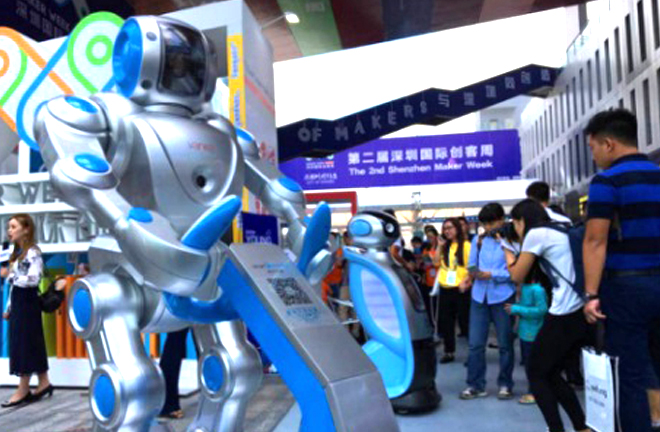Shenzhen emerging as global hub of innovation

The 2016 National Mass Innovation and Entrepreneurship Week and the concurrent 2nd Shenzhen Maker Week in Shenzhen
A vanguard of China’s Reform and Opening-up, Shenzhen is becoming a global hub of innovation. Constant innovation has been essential to Shenzhen’s rapid rise over the last four decades from a fishing village to a cosmopolitan city.
The city’s Nanshan District, home to many enterprises with outstanding core technical capabilities and integrated innovation capacity, is on its way to becoming China’s Silicon Valley. The district has advantages in electronic information, internet industry, medical devices, biopharmaceuticals, intelligent manufacturing, new energy and new materials, among others. The district is also home to more than 200 co-working spaces, 1,700 innovation and entrepreneurship groups and 6,500 tech hobbyists called “makers.” The Shenzhen Bay Innovation and Technology Centre located in this district has become a flagship of national mass innovation and entrepreneurship. It is home to 45 incubators and entrepreneurship service agencies, and over 200 innovation and entrepreneurship teams in the internet industry and intelligent hardware.
Chinese President Xi Jinping delivered important instructions on Shenzhen in January 2015, affirming that the city needs to keep its mission firmly in mind, have the courage to innovate, continue to create new advantages, and elevate itself to a new level.
In his report at the ninth plenary session of the sixth Shenzhen CPC committee, Wang Weizhong, secretary of the CPC Shenzhen Municipal Committee, mapped out a blueprint for the city, promising that Shenzhen will be developed into a modern, international and innovative city and finish building a moderately prosperous society in all respects with a high quality by 2020. It will develop into a sustainable global hub of innovation and realize socialist modernization by 2035. The city will have become a representative of a special economic zone of a strong modernized socialist power and an innovation-oriented global city with excellent competitiveness and influence by the middle of the century.
A thriving culture is indispensable to a city’s sustainable development. Shenzhen’s continued success hinges on its ability to become a culturally vibrant and creative city, said Li Jingze, vice-president of the Chinese Writers’ Association.
A young symbolic city in China, Shenzhen attaches importance to innovation in the cultural industry. Ever since the city initiated a strategy for a culture-based city in 2003, its cultural and creative industries have grown at an average annual rate of 20 percent for 13 years in a row.
According to the statistics of some research institutes, Shenzhen’s cultural and creative industries produced added value worth 195 billion yuan in 2016, increasing by 11 percent from last year. Their share of the total GDP reached 10 percent. The value was projected to be 215 billion in 2017. Shenzhen has embarked on a new path of “culture plus science and technology.”
Shenzhen has achieved the integration of culture and the latest technologies such as digital technology, information technology and internet technology, standing at the forefront of cultural innovation in China and the world.
Li Fengliang, director of the Institute for Cultural Industries at Shenzhen University, said that Shenzhen is not a city with rich cultural resources, but its cultural industries, including public services, have done a good job. Shenzhen owes this success to the local government’s emphasis, the market mechanism, scientific and technological support, financial support and policy guidance. “Over the past decade, Shenzhen’s new model characterized by the integration of culture and technology is the most developed among the cultural industries in China and even in the world.”
Shenzhen’s cultural industries, especially creative design, have also won international recognition. In 2008, UNESCO officially approved Shenzhen to join the Creative Cities Network. Shenzhen was awarded “City of Design,” the first in China and the seventh in the world. In 2010, Shenzhen hosted an international conference of the UNESCO Creative Cities Network. Starting from 2011, the “Shenzhen Design Award for Young Talents” has been settled in Shenzhen.
Through a convenient platform for international cooperation and exchange in the creative field, Shenzhen leads the trend of cultural and science and technology industries in the Pearl River Delta and even the whole country with a broader international perspective.
(edited by JIANG HONG)
